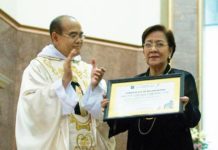TIME magazine correspondent Nelly Sindayen was never without her malong, a colorful, traditional hand-woven or machine-made tube cloth that speaks of her Southern roots. She would usually tie this on one shoulder and on top of the cotton shirts and blouses she wore while doing her rounds as a journalist under the tropical sun.
Yet woven in her “signature” garment is her 59-year journey in a smorgasbord of “shoe leather” journalism, cultural diversity, friendship, love for singing, and most of all, the principles that made her the journalist of her calibre.
Nelly suffered from diabetic stroke and died in her sleep on April 4, 2009 –three days before her 60th birthday. She was buried in a Muslim cemetery in Taguig City.
Nelly was known for being one of the few who practiced “shoe leather” journalism or the good ‘ol way of gathering news through extensive legwork and exceptional nose for news. Her exceptional news-gathering skills got her exclusive stories right from the pulp—from the disappearance of former President Marcos’ son-in-law to the 2006 coup d’etat plot on now outgoing President Macapagal-Arroyo.
But as a writer for an international newsweekly, this Thomasian journalist always knew she had to do more–squeeze the pulp dry.
No stone left unturned
“The Case of the Missing Groom” was probably one of Nelly’s biggest breaks. It tackled the disappearance in 1983 of sportsman Tommy Manotoc, husband of the late strongman’s daughter Maria Imelda “Imee” Marcos. A typical reporter would tell the story as it is: husband dined with his wife, after which was escorted by security men to Malacañang Palace, while the husband took off and “disappeared.” Manotoc’s mother blamed President Marcos for the disappearance, but he denied the accusations.
It would have been a simple account of a missing person if Nelly did not write what others missed: Manotoc was not rich in his own right, having “no real wealth of his own,” and was previously married to a beauty queen who was the daughter of a sugar planter and who bore him two kids. But they divorced when Manotoc met Imee, whom he married secretly in the United States.
United Press International correspondent Fernando del Mundo wrote: “Nelly was still in the Manotoc home. She had called me from there hours after I had filed my lead to the United Press International headquarters in New York. ‘It’s embarrassing that I’m the only one left here,’ she told me, laughing dry. ‘But you know,’ she said, ‘I have to squeeze the story dry or it will not see the light of day because you guys have reported everything to the world.’”
Manotoc surfaced 40 days after his disappearance and claimed that he was kidnapped by Communist guerrillas.
Nelly was not only competent with her stories, but also tough-skinned and fiercely determined just like any journalist should be. But this was no easy feat especially during the Martial Law years.
She and fellow reporter Marilyn Odchimar found themselves in danger after covering a demonstration at St. Joseph’s College in Quezon City, which was eventually surrounded by the military that peeved on soirees of left-wing ideologues. Friends had called help for the two reporters, who were driven off by the military to a police station for questioning.
“Oh Marilyn, good thing it was only your bag that was searched,” Nelly said after the ordeal. “I was scared stiff while he was inspecting your bag. I have here a letter from Nur (Misuari, the wanted leader of the Moro National Liberation Front). It has details on where, when we’re supposed to meet.”
Nelly also kept her watchful eye on the presidents who came after President Marcos through her stories: “The Philippines a Muddle-Thorough Mode,” which talks about the coup d’états during former President Aquino’s administration; “The Ramos Touch,” which discusses former President Ramos’ efforts to salvage the country’s economy; and “Acting Leader,” which rated and revealed former President Estrada’s performance as a leader.
Journalist holds ground
Nelly’s principles as a journalist were tested big time in the twilight of her career. She had to choose which call to answer: the call of her professional ethic or the call of her duties as a Filipino?
“Inside the Philippine’s Coup Plot” by Bryan Walsh of Time talks about a gathering-turned-coup plan in 2006 against the Arroyo administration. Nelly was perched among the guests of Jose “Peping” Cojuangco, the late President Aquino’s brother, until details of withdrawing support from the government suddenly transpired. Nelly took in all the facts and later filed the story with Time magazine.
After the story came out, she was summoned by the Department of Justice to detail everything that happened during that gathering with Peping Cojuangco. The situation almost compromised the safety of her sources and her obligation to the state, lest she be accused of rebellion. But Nelly knew very well the profession she was in.
“For a while, she dodged [former Justice Secretary Raul] Gonzalez’ agents and moved around with a couple of bodyguards who looked like hardened Tausug warriors,” wrote Monica Feria in the Philippine Daily Inquirer. “Then she disappeared.”
Nelly kept mum and flew to Hong Kong instead. Later on, she returned to the Philippines. And when the issue finally died, she was back on her feet, appearing in press conferences and socializing with her friends and peers.
Best of both worlds
The colorful streak of Nelly’s malong only showed how unique she was: the child of a Christian father and a Muslim mother, a pure-blood Tausug who had a spanking career in the city, and had lived a private family life while spewing rainbows in the parties she had thrown for friends and colleagues.
Nelly grew up in Siasi, a trading post strategically located between Jolo and nearby Malaysian ports, under the cultural backdrop of Muslims, Christians and other minorities.
Nelly was still young, but death already took a lot from her family–first her father, then her stepbrother, and eventually, her mother. But the events only made Nelly become the tough and independent woman she was until her death.
Nelly moved to Manila and studied journalism in the then Faculty of Philosophy and Letters and graduating in 1966.
“When she was a student here in UST, she was self-confident, someone who had already worked professionally and was no longer shy and timid,” said UST Journalism professor Alice Villadolid.
Nelly taught at the Notre Dame of Jolo College and wrote for the Sulu Star. But when it closed during the Marcos era, Nelly relocated to Manila to pursue working in various media outfits such as the Bulletin Today, Japanese news agency Yomiuri Shimbun and the Far East Economic Review. Working for a foreign press, Nelly became a member of the Foreign Correspondents’ Association of the Philippines until she became a stringer for Time.
More than being a hardcore journalist, “Nelly was different,” Anthony Spaeth, Nelly’s long-time colleague in Time said in a eulogy. “She led a life that will be remembered not just by relatives or aspiring journalists or the politicians she loved and hated, but by anyone who met her. When you lead a life with a unique shape, of your own carving, with nerve and verve, well…They call that inspiration. [And] everyone felt it.”
Philippine journalism may have lost a prolific daughter, but Nelly’s life will always be remembered like the colors of her malong–vibrant, adventurous, but no nonsense and still straight to the point.









